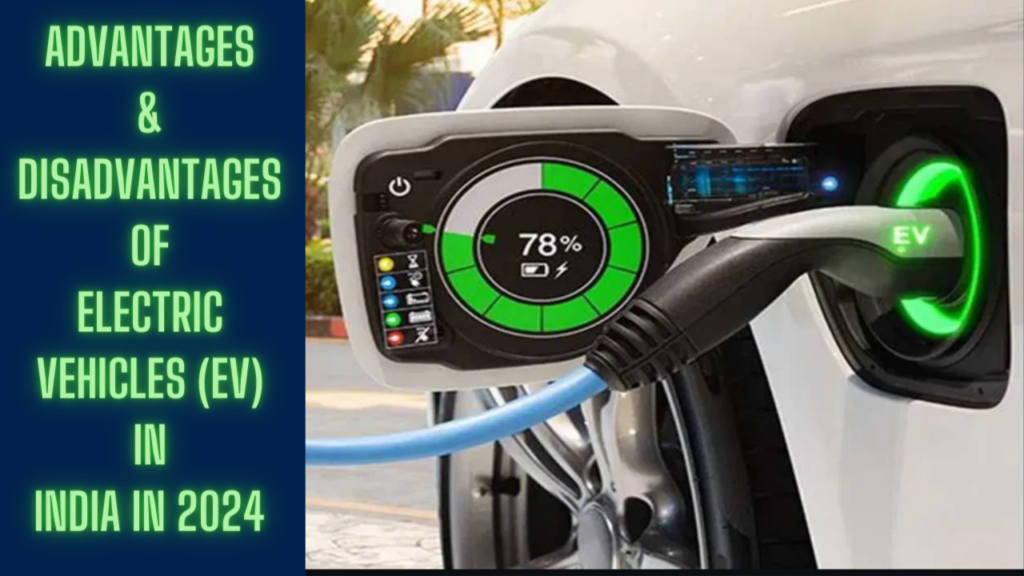In the last few years with a slow but effective gush of electric vehicles (EVs) the Indian automobile industry was suddenly transformed.
Meanwhile, as it struggles with its environmental difficulty and paves the way for sustainable alternatives, electric vehicles are beginning to reveal their advantages in more fields.
Hybrid and Hydrogen vehicles are already in the line for production but that has not stopped the electric car from entering a new era: greener and more profitable!
Let’s understand what could be the advantages and disadvantages of electric vehicles (EVs) in India in 2024.
Eco-Friendly:
The main advantages of electric vehicles occur at home. Reducing Air Pollution in a country overwhelmed by air pollution and environmental degradation, electrification is important.
In particular, the air pollution caused by exhaust fumes is one of the very big issues in India’s urban centres caused.
Electric vehicles do not produce any exhaust and instead of emitting such harmful substances as carbon monoxide, nitrogen oxides or particulates from their tailpipes.
This could significantly improve air quality in many parts of cities, especially densely populated ones.
Reduce fuel expenses:
Charging an electric car is often cheaper than using traditional fuel, which eventually results in substantial energy savings.
These days, all kinds of public and private charging infrastructure are popping up. It allows electric vehicle owners to have the convenience of being able to plug in at home or on road trips without needing frequent pit-stops at typical gas stations.
Reduced maintenance costs:
Electric vehicles contain fewer moving parts than traditional cars. As it has fewer parts, this also means less regular maintenance is necessary.
Owners of electric cars enjoy savings here as well: they don’t have to pay for changes of oil, fixes for the exhaust system and other things that are common maintenance needs with traditional autos.
Government Initiatives:
India’s government has recognised the potential of electric vehicles and introduced various incentives to encourage the take-up of electric vehicles.
This serves to make electric vehicles more affordable and more economically attractive for consumers.
Tax incentives:
The government provides tax benefits for both manufacturers and buyers of electric cars.
These benefits may include Goods and Services Tax (GST) breaks, rebates on income taxation and so forth [‘may also include benefits.’]. Thus, electric vehicles have been made an economic choice.
Some states in India are reducing registration fees for electric vehicles, further reducing the overall cost of ownership.
This has caused a greater focus on electric vehicles as potential buyers consider the benefits of such a new investment and the general industry thus both changes its methods and finds ways to make them more environmental.

Technological Innovation:
Electric vehicles are a good example of this kind of shift in underlying technological paradigms.
From batteries to charging infrastructure, these innovations have the potential to revolutionize India’s transportation future.
Advances in Battery Technology:
The heart of any electric vehicle lies in its battery.
With research and development efforts still ongoing on battery technology, improvements in energy density, charging speeds, and overall performance can reasonably be expected over time while at the same time costs for batteries themselves decrease.
Charging Infrastructure Development:
An electric vehicle consumer must have the right conditions in order to enjoy life by having a conveniences and public housing with sufficient charging.
Consequently, there has been a wave of investment and innovation in charging technologies and distribution systems. The uniformity of charging stations for electric cars nationwide is making owning an electric vehicle in India increasingly practical and easy.
Conclusion:
The benefits of electric vehicles in India go beyond personal practicality and contribute to the broader goal of sustainable development.
The shift to electric vehicles in India is a concrete manifestation of its commitment to a cleaner and greener future, not just because it will reduce greenhouse gas emissions as well as mitigate air pollution for more than 50 per cent of commuters living in the cities where we work together. It also fits nicely with such Nobel Prizes as Integrated Chronic Air Pollution Control which were awarded for technologies that fixed specific sources of dirty fuel so these cars can further improve on their record while operating on much cleaner, more modern technology like hydrogen fuel cells or ethanol plants. So, although electric vehicles in India still face problems like a lack of charging infrastructure and high acquisition costs, the general trend is inevitable. Since the government has moved on campaigns, even greater numbers of models will be introduced to Indian consumers in future as comprehensive access gains ground.
And although leading the way for national-scale transformation efforts, electric vehicles have already become agents for this change in form. At last, we can glimpse a cleaner, more efficient, greener future being built together as nations team up in earnest to achieve. Any long, circuitous-and the per-circuitous-road That sounds reasonable on the face of it. But the advantages of electric vehicles make them key players in India’s move toward a sustainable and robust transport system.
